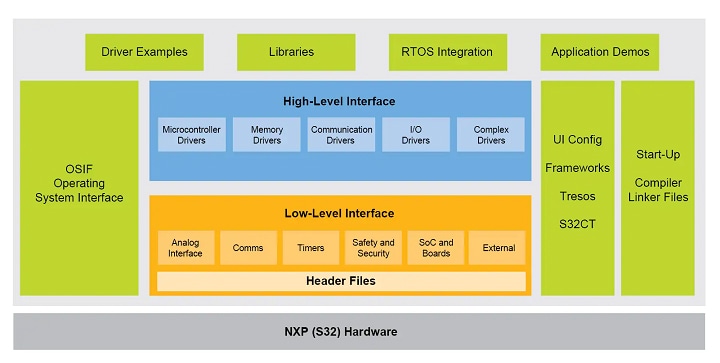Electronic devices are multiplying in modern vehicles due to new safety, security and
connectivity-related features increasingly being part of the latest vehicle architectures.
Automotive software is also emerging as the central development challenge. With the rising number
of ECU components within vehicles and added software content, engineers are incorporating AUTOSAR
and low-level drivers to address these challenges.
Historically, NXP has offered separate driver support packages for AUTOSAR and non-AUTOSAR
software. The first type addresses critical automotive functional safety software drivers, called
AUTOSAR microcontroller abstraction layer (MCAL) for which NXP offers both development and
production licenses. MCAL license costs can present a challenge to customers with limited
development budgets. The second type of software drivers are software development kits (SDKs),
which provide customers the MCU low-level drivers and additional software for initial development.
NXP automotive SDKs offer production-grade quality but do not meet AUTOSAR safety compliance.
Engineers need to maintain separate software if they use an MCU across multiple safety and
non-safety applications or projects.
How NXP Is Helping Shape the Next Generation of Safety Software
NXP challenged itself to build one software package to address both AUTOSAR MCAL functional safety
software and non-AUTOSAR software.
NXP released Real-Time Drivers (RTD) software to customers
to helping maximize software reuse across processor platforms and broaden AUTOSAR access for
mass-market developers. RTD is one of several offerings in the S32 software enablement platform.
RTD is complimentary with all S32 automotive processors and offers unique code and safety
scalability across the S32 platform. RTD includes a package of production-grade, safety-compliant
software drivers that aim to simplify AUTOSAR software development up to ISO 26262 ASIL D and
support non-AUTOSAR development. The use of a common code base and software API helps maximize
software portability across processor platforms. At the same time, the inclusion of the production
license in the silicon price broadens AUTOSAR access for mass market developers.
What Does Real-Time Drivers (RTD) Software Include?
Comprises two APIs: Low-level interfaces (LLI) and high-level interfaces (HLI). HLI can be used in
AUTOSAR and non-AUTOSAR applications, while LLI’s can be used only in non-AUTOSAR applications.
Both have functionalities for MCU, memory, communication, I/O and complex drivers containing
aspects for analog, safety, security, header files and others.
RTD was developed using SPICE/CMMI Level 3, MISRA 2012 testing and ISO 26262 compliant processes.
RTD software may include additional middleware stacks for LIN or TCP/IP and system basis chip
(SBC), Ethernet/CAN PHY drivers and FreeRTOS support upon chosen S32 processor. RTD also includes
API extensions for additional IP coverage.
RTD software is integrated into NXP's S32 Design Studio (S32DS) IDE and is supported across
multiple IDE toolchain vendors. RTD softwares are configurable using the S32 configuration tool
contained within S32DS or tools from AUTOSAR 3rd parties such a Elektrobit’s EB tresos Studio™
or Vector’s DaVinci Configurator Pro™. RTD includes drag/drop functionality,
comprehensive documentation, source code and example/project code for quick application setup.
 Real-Time Drivers (RTD) architecture
Real-Time Drivers (RTD) architecture
To better experience download the
block diagram.
What Are the Benefits of RTD?
For many startups and medium-sized customers, the upfront software licensing costs are too
burdensome to absorb on small volume projects. Implementing AUTOSAR MCAL software would
historically incur significant costs early in the development process. Still, these projects now
have the benefit of leveraging NXP’s RTD software for initial prototype development and into
production.
Together with the numerous safety features on the S32K3 MCU, the use of an ISO 26262-compliant
development process for RTD allows any automotive or industrial application to implement
functional measures in both hardware and software.
While S32K1 launched with production-grade quality SDK software and paid AUTOSAR MCAL software
licenses, we now offer S32K1 AUTOSAR MCAL customers to migrate to RTD software at no cost. We will
continue supporting and selling AUTOSAR MCAL packages by request through late 2022 but expect most
customers to migrate to the RTD software now that it is released.
Another advantage to allowing customers to implement RTD software on all of their projects
translates to internal software flexibility, resource and time to market-saving. The use of a
common code base and software API helps maximize software portability across S32 processor
platforms.
Watch a quick RTD introduction.
In summary, the introduction of Real-Time Drivers (RTD) software for AUTOSAR and non-AUTOSAR
development creates a turning point for broader safety implementation and meaningful cost savings
for customers who decide to use this valuable and no-cost software moving forward. RTD software is
currently available for multiple automotive S32 processors including S32K1, S32K3, S32G2 with
additional products planned. All future NXP automotive S32 processors will offer RTD software.
Learn more about Real-Time Drivers at
www.nxp.com/RTD.





